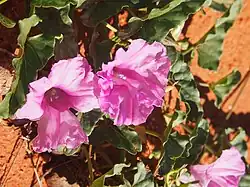Ipomoea muelleri
| Ipomoea muelleri | |
|---|---|

| |
| Scientific classification | |
| Kingdom: | Plantae |
| Clade: | Tracheophytes |
| Clade: | Angiosperms |
| Clade: | Eudicots |
| Clade: | Asterids |
| Order: | Solanales |
| Family: | Convolvulaceae |
| Genus: | Ipomoea |
| Species: | I. muelleri
|
| Binomial name | |
| Ipomoea muelleri | |
Ipomoea muelleri is a vine in the Convolvulaceae family.[2] It is native to the Northern Territory, Queensland, South Australia, and Western Australia.[3]
It was first described in 1868 by George Bentham,[2][4] and the specific epithet, muelleri, honours Ferdinand von Mueller.[4]
Habitat
It is found in open forest and at the edges of monsoon forests and vine thickets.[5]
Aboriginal names & uses
The Alyawarr speaking people call it anaytapaytap, twatywert; the Anmatyerr: atywert-atywert; the Kaytetye: atywert-atywerte, kalamp-atywert-atywerte; the Warlpiri: karlampi-jurtujurtu, ngarlangkartapi, yutajiti.[1]
The Warumungu people of the Kimberley call it Karlampijurrujurru and dig out the young tubers (yams) to roast on hot ashes.[6]
References
- ^ a b https://eflora.nt.gov.au/factsheet?id=1413
- ^ a b "Ipomoea muelleri". Australian Plant Name Index, IBIS database. Centre for Plant Biodiversity Research, Australian Government. Retrieved 2024-11-26.
- ^ "Ipomoea muelleri Benth. | Plants of the World Online | Kew Science". Plants of the World Online. Retrieved 2024-11-26.
- ^ a b Bentham, G. (16 December 1868), Flora Australiensis 4: 423
- ^ Zich F.A., Hyland B.P.M., Whiffin T., Kerrigan R.A. (2020). "Ipomoea muelleri". Australian Tropical Rainforest Plants, Edition 8. Retrieved 2024-11-26.
{{cite web}}: CS1 maint: multiple names: authors list (link) - ^ Michael Jampin Jones; Sandra Nangali Morrison; Ronald Jungarrayi Morrison; et al. (2022). Warumungu Plants and Animals. Department of Environment, Parks and Water Security. p. 131. ISBN 978-1-74350-317-1. Wikidata Q130753534.
